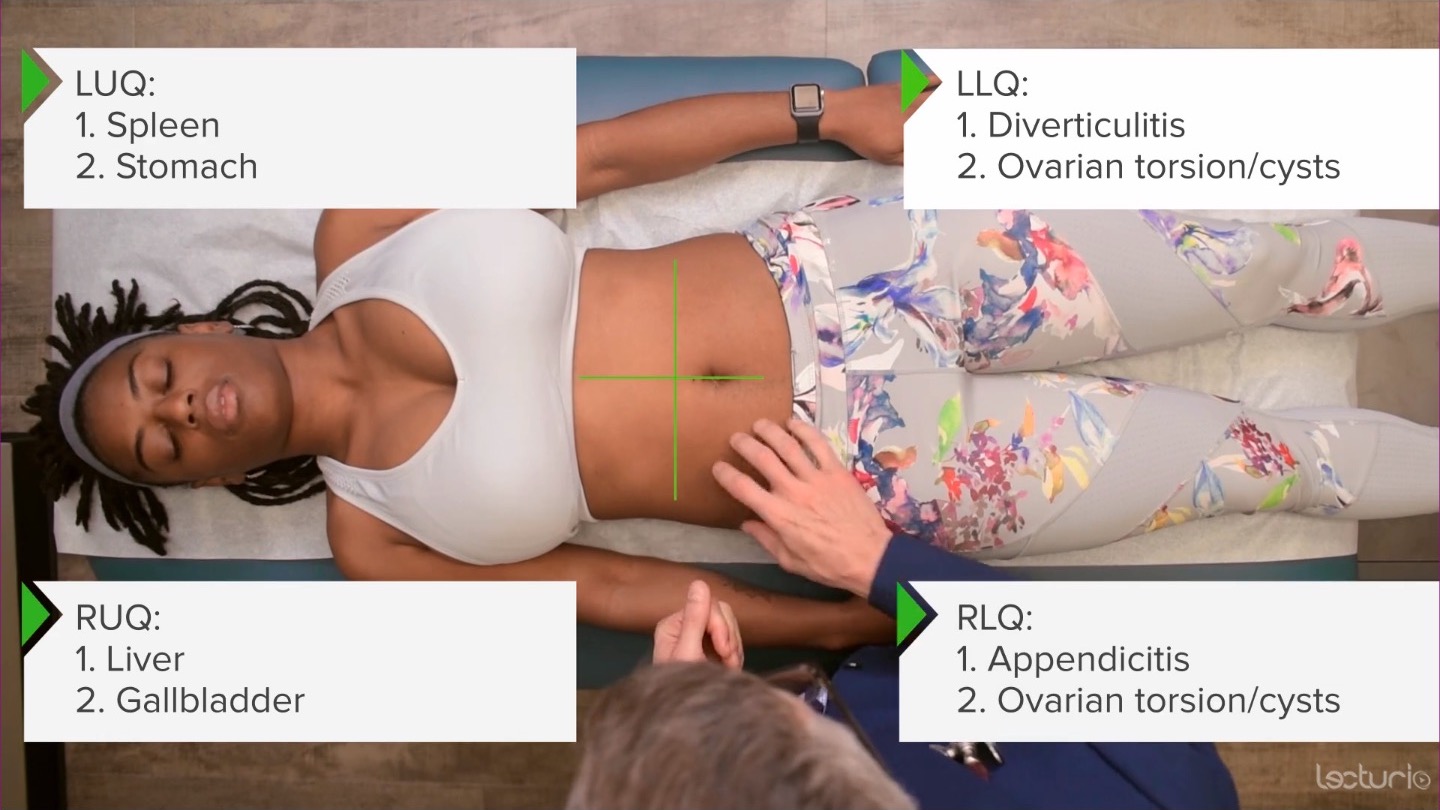Playlist
Show Playlist
Hide Playlist
Abdominal Pain: Diagnosis
-
Emergency Medicine Bord Approach to Abdominal Pain.pdf
-
Download Lecture Overview
00:01 So next we wanna move on to lab testing, and we wanna think about what tests to get for these patients. 00:06 A majority of patients who come to the Emergency Department for abdominal pain will get blood test sent. 00:12 A key and very important test that you wanna make sure you send is an HCG test for all women of childbearing age. 00:20 HCG is the hormone that’s secreted in pregnancy, and this test can be done very rapidly and easily using a urine pregnancy test. 00:30 You can also send a serum pregnancy test which will give you a more accurate reading as to what the number is, but generally, urine pregnancy tests are very sensitive for pregnancy. 00:42 A CBC or a complete blood count is the next test that's generally sent. 00:47 It’s important to note that this is not a specific test. 00:50 When we send this test, we are looking at the white blood cell count. 00:53 A white blood cell count is a non-specific marker of stress on the body. 00:57 It goes up in times of infection, but it also goes up in lots of other things. 01:03 It can increase in and of itself in pregnancy. 01:05 It can increase just with stress, life stress. Certain medications can increase the white blood cell count. 01:12 Also on that CBC, you’ll get an idea as to whether or not the patient is anemic, which can also potentially help you. 01:19 A metabolic panel with liver and pancreatic testing can be helpful as well, so that will give you an idea as to what the kidney function is, what the glucose level is. 01:29 It'll tell you if the patient is having any liver issues, any indication if the patient is having increase of their pancreatic enzymes. 01:38 An important thing to note here is that lipase is generally the test that should be sent for pancreatitis. 01:43 Amylase and lipase are both pancreatic enzymes, but amylase is also secreted in other things. So amylase can come from the bowel wall in general and also salivary glands. 01:53 So for the most part, to practice the most cost-effective emergency medicine, just go ahead and send a lipase. 02:00 The lactic acid level is something else that can help. 02:02 Lactate is elevated due to periods of ischemia. 02:06 So it can be due to volume depletion, it can be due to there not being enough blood flow to the tissues, it can also be due to infection and possibly sepsis. 02:14 So sending a lactate can indicate to you whether or not the patient is having elements of decreased blood flow to their tissues. 02:23 Other testing to get would be an EKG. 02:26 The EKG can evaluate for myocardial ischemia. 02:29 So again, I wanna stress that that’s classically associated with inferior wall MIs. 02:33 So patients who are having epigastric abdominal pain, always think about that inferior wall MI. 02:40 A urinalysis can also look for blood, which would be indicative of possibly a kidney stone. 02:44 It can also look for white blood cells and nitrites and leukocyte esterase, and see if there’s any concern for infection. 02:51 The other thing you can do on your urine test is you can send a urine test, especially in a male patient for gonorrhea and chlamydia testing. We’ll talk more about that in another lecture as well. 03:01 After we send off our blood tests, we definitely wanna start thinking about whether or not our patient needs abdominal imaging. 03:08 We have a few choices when we’re thinking about abdominal imaging. 03:12 The first thing that we can do is possibly a plain film. 03:15 A plain film is basically used to evaluate for bowel obstruction or possibly perforation of the viscus. 03:23 Now, the advantages here are this can be performed very quickly. 03:27 So you can have someone come do a portable abdominal x-ray very quickly right at the bedside. 03:33 So it’s good for a sicker patient potentially, or for a patient you don’t feel safe leaving the department, or someone in whom you wanna get testing very rapidly. 03:42 The disadvantages are that this is a low-yield test. 03:46 This test is not gonna give you a ton of information, and the truth is, is that if it's negative, you potentially may need to still move on and get additional testing. 03:56 So if you’re worried that someone has perforation of their intestines, you actually wanna go ahead and you want to get an upright chest film. 04:04 And the reason for that is that the free air that's in the abdomen will go up, and you’ll be able to see it more accurately under the diaphragms. 04:13 Now again, I wanna stress, that this is not the most sensitive or specific test for either bowel obstruction or perforation. 04:20 So if you are very worried about those conditions, you're gonna wanna move on and get a CAT scan. 04:25 Ultrasound is another option when looking for pathology in patients who are coming in with abdominal pain. 04:32 So what is ultrasound good for? Ultrasound is good for looking for an abdominal aortic aneurysm, which is what’s pictured over here in this picture on the side of the screen. 04:42 You can go ahead and take a look and see how big the aorta is, gallbladder stuff as well as genitourinary conditions like testicular torsion or ovarian torsion. 04:54 It may also help in renal colic. 04:56 So you can get an ultrasound of the patient's kidneys and see if there's any obstruction. 05:00 You can look at the appendix, that’s very operator dependent. So some people, when they’re performing ultrasound, are very good at looking at the appendix, and that's actually, ultrasound is the most common imaging modality that's used when working up pediatric patients for appendicitis. 05:17 It can also be used for bowel obstruction. 05:18 There's a lot more evidence for using it for this in the European literature than the American literature, but that may be something that becomes a lot more common moving forward that ultrasound is used for bowel obstruction. 05:30 The advantages here are that there’s no radiation exposure, so you’re not exposing your patient to any radiation, and that’s one of the big disadvantages of CT scan, and it can also be performed at the bedside. 05:41 In the Emergency Department, we’re generally pretty proud of our point-of-care ultrasound skills, which basically means that we have ultrasound machines in the Emergency Department that we’re bringing to the bedside, where we can actually look for a lot of this stuff on our own. 05:54 So if you're at a facility that doesn't have ultrasound capabilities available to you, one of the ED staff can most likely go ahead and take a look for a lot of these conditions. 06:05 And we can also do it very quickly and on our time. 06:07 We don't need to wait for anyone to come or be there, we can go ahead and get that test taken care of on our own. 06:13 And of course, depending on your comfortability with it, you may need to go ahead and get additional testing. 06:18 So the disadvantage here is that it’s operator dependent. 06:21 So it’s dependent on how comfortable people feel obtaining those images 'cause it does take a little bit of skill and a little bit of practice, or rather a lot of skill and a lot of practice, to get good at it and to really be able to know what you’re looking at and know what you see. 06:33 I always joke around that I tell students nowadays that when I was a student, I thought everything on the ultrasound looked like a snow storm. 06:39 It’s all like black and white and gray, and I had no idea what I was looking at. 06:42 So for students now, generally there's a lot more teaching about this in medical school, and it’s really a great resource for you to get your hands on and get comfortable with. 06:51 The last imaging modality is CT scan. 06:53 CT scan is the thing that’s used very commonly when looking for abdominal pain issues. 06:58 What it’s good for is mostly intra-abdominal diagnosis. 07:01 So this is good for looking for appendicitis, it’s good at looking for any kind of bowel obstruction, it's good at looking for any kind of infection or abscess in the abdomen. 07:12 The advantages here are that it’s generally readily available, and the image quality is oftentimes great. 07:18 You’re able to see lots of different stuff, and you’re able to evaluate for lots of different conditions. 07:23 The disadvantage here is that it’s ionizing radiation exposure, so you’re exposing someone to radiation, and that matters because over the course of a lifetime, we know that radiation exposure can add up and potentially put patients at increased risk for malignancy. 07:37 So we wanna make sure that we’re being thoughtful about when we’re using this, and we wanna make sure that we’re using it in the appropriate patient setting. 07:44 And if you're worried about any kind of vascular concerns, you wanna go ahead and give intravenous contrast, and that’s going to help light up the blood vessels and make them easier to see. 07:54 Now, like lots of things that we’ve talked about during the emergency medicine lectures, it's important to always maintain a high level of suspicion of some kind of badness going on in elderly patients, immunocompromised patients or diabetic patients. 08:09 You wanna have a high level of suspicion that they have something bad going on in their abdomen. 08:15 They may not necessarily have clear signs or clear exam, symptoms or lab values, but have a low threshold in these patients for potential imaging or possible surgical consultation. 08:26 Definitely, the one thing you don't wanna do in these patient populations is you don’t wanna necessarily always jump to a more benign diagnosis like reflux. 08:35 You wanna have a high suspicion that something could be going on in their abdomen.
About the Lecture
The lecture Abdominal Pain: Diagnosis by Sharon Bord, MD is from the course Abdominal and Genitourinary Emergencies. It contains the following chapters:
- Abdominal Pain: Diagnosis
- Imaging Studies
Included Quiz Questions
In the evaluation of patients with abdominal pain, what is the laboratory test that must be done on all people who can get pregnant?
- HCG test
- Complete blood count
- Lipase
- Serum lactate
- Amylase
Which of following blood tests is the most specific for acute pancreatitis?
- Lipase
- Amylase
- CBC
- Lactate
- AST
What is the major advantage of bedside ultrasound over CT scan in the evaluation of abdominal pain?
- No radiation exposure
- Readily available
- Evaluates aortic aneurysm
- Evaluates renal disease
- Operator dependent
Abdominal plain films are obtained in a patient with abdominal pain to evaluate mainly for...?
- Bowel obstruction or perforation
- Abdominal aortic aneurysm
- Abdominal hemorrhage
- Renal colic
- Cholecystitis
Customer reviews
5,0 of 5 stars
| 5 Stars |
|
1 |
| 4 Stars |
|
0 |
| 3 Stars |
|
0 |
| 2 Stars |
|
0 |
| 1 Star |
|
0 |
This lecture is very well explained with great detail and tips.




